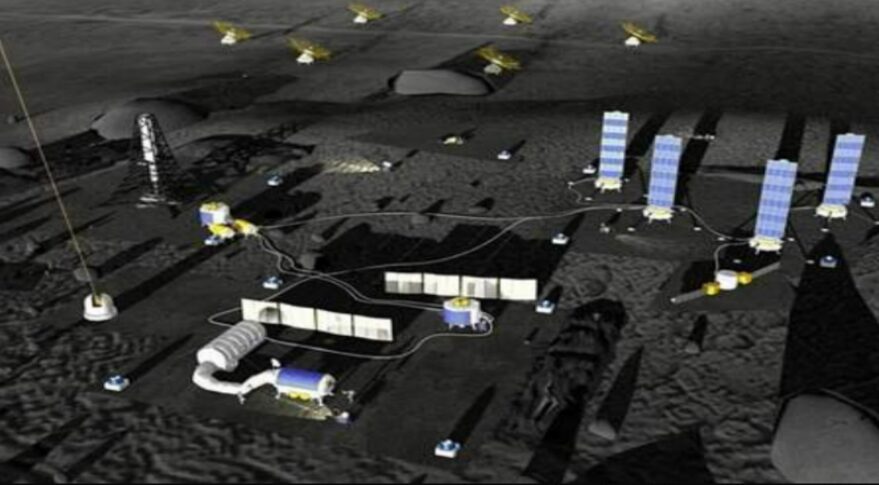After rejecting the offer from the US over joining their multi-national Artemis Moon program, Russia is reportedly preparing to sign a memorandum of understanding with China to partner with the country in setting up an International Lunar Research Station.
One Of The Biggest Explosions In South Asia Captured By Satellite Images: Watch
Russian media is abuzz with reports that Prime Minister Mikhail Mishustin has instructed Roscosmos, Russia’s state space agency, to initiate a partnership with China to set up a Scientific Lunar Station on the moon.
“Roscosmos has completed domestic proceedings to harmonize the Memorandum of Understanding between the Government of the Russian Federation and the Government of the People’s Republic of China on cooperation to create the International Lunar Research Station,” SpaceNews reported quoting the statement of Roscosmos Press Office on February 17.
The Russian space agency confirmed to SpaceNews that the date to sign the MoU has not been determined yet and that discussions with the Chinese partners are on.
The Russian government had published an online notification signaling the signing of the MoU with China on February 11.
Interestingly, the country chose not to be part of the US’ Artemis lunar exploration program, which aims to land humans on the moon by 2024 and set up a permanent base to aid deeper space missions. However, NASA’s new administrator has cast a shadow on that deadline, saying the target of 2024 may not be feasible.
The Artemis program also envisions the establishment of a Lunar Gateway, which is a small space station in lunar orbit that would function as a fuel and supply depot, a science outpost, and a waypoint for missions to and from the lunar surface.

The US-led program has at least eight participant countries, including Australia, Canada, Italy, Japan, and the UAE, and according to the former NASA chief Jim Bridenstine, “Artemis will be the broadest and most diverse international human space exploration program in history”.
The chief of Russia’s space corporation, Dmitry Rogozin, last year said his country was not interested in such a project, saying the choice of the year 2024 as landing target represented a decision representing political reasons.
“It’s more of a political project for the US now,” Rogozin said of Artemis, talking Russian tabloid newspaper, Komsomolskaya Pravda last August. He even compared the Artemis coalition with the US-led NATO.
However, Rogozin was optimistic about space exploration ties with China on such projects. “We respect their results,” he told the newspaper, adding that the Asian nation “is definitely our partner” moving forward.
Russia and China are now moving forward to partner in establishing a robotic base on the moon at its south pole. China may kickstart the work soon with the launch of its Chang’e-,6, 7, and 8 missions, along with Russia’s Luna 27.
The two countries are hoping to operationalize the International Lunar Research Station (ILRS) by the early 2030s to involve long-term robotic and potentially short-term crewed missions. The mission for human landing is slated to occur between 2036 and 2045.

The project, expected to be led by Russia and China, could invite other nations for partnership in technology and financial domains. ILRS envisages the “construction and operation of human[ity]’s first sharing platform in the lunar south pole, supporting long-term, large-scale scientific exploration, technical experiments and development and utilization of lunar resources,” according to a 2020 presentation to the Scientific and Technical Subcommittee of the Committee on the Peaceful Uses of Outer Space (COPUOS) last year.
SpaceNews quoted Zhang Ming, a researcher on international security and space issues at the Shanghai Academy of Social Sciences, as saying that “both China and Russia, who have long cooperated in space, have difficulties in working with the US for different reasons”.
According to Zhang, Russia wasn’t happy about the “US-centric” Artemis program and she would expect “more and more space and lunar cooperation between Russia and China” if the “United State continues its space policies and practices without any change”.
Experts say it would be hard for Russia to ignore its military and geopolitical rivalry with the US and join hands with the country on such an important program, especially when its friendly ally China has more ambitious plans for the moon.
With the US ganging up against Russia and China militarily through the QUAD grouping, it would be difficult for Putin to overlook the rising aggression against its interests. Joining the China-led moon program was, therefore, a natural choice for the country, the experts say.
China plans to establish its ambitious ILRS project through a series of upcoming robotic Chang’e missions across the 2020s and expanded through the 2030s.
Follow EurAsian Times on Google News




